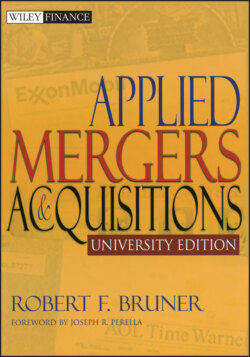Читать книгу Applied Mergers and Acquisitions - Robert F. Bruner - Страница 112
Microeconomic View
ОглавлениеThis second perspective on a country considers activity at the level of industries and firms. Of general interest to the analyst will be the demographic profile of the country’s industrial base, the breadth of different industries, their maturity, and their prosperity. Central to microeconomic analysis is an understanding about average and marginal costs and revenues as indicators of the competitive advantage of individual firms, of entry barriers, and of the competitive makeup of industries. This view of a country is rooted in theory and research of industrial organization economics.
Porter (1990) argues that country performance is essentially a matter of microeconomic performance. Conventional thinking about national competitiveness, he says, is rooted in macroeconomics: trade balances, interest rates, exchange rates, labor costs, and economies of scale. Instead, he argues that national performance can be traced to processes of innovation and productivity improvement at the level of industries: “The only meaningful concept of competitiveness at the national level is productivity…. A nation’s standard of living depends on the capacity of its companies to achieve high levels of productivity—and to increase productivity over time. Sustained productivity growth requires that an economy continually upgrade itself.” (Page 76) Based on an analysis of competitive success in 10 trading nations, Porter concludes that the ability to innovate and to improve productivity resides in four interrelated factors. Exhibit 5.11 depicts these factors in the “diamond” of national competitive advantage:
Factor conditions. These regard the inputs of production, such as labor, land, natural resources, physical facilities, and infrastructure. Human resources and intellectual capital are especially important in advanced national economies. Here the analyst should assess how specialized are a nation’s factors, and how tailored they are to the needs of the acquisition target. Porter argues that “nations succeed in industries where they are particularly good at factor creation. Competitive advantage results from the presence of world-class institutions that first create specialized factors and then continually work to upgrade them.” (Page 79)
Demand conditions. The home-market demand for the goods or services of an industry will heavily influence the international success of that industry. Effective home demand can telegraph to domestic firms an earlier and clearer assessment of customer needs—the guidance from home demand is more important than its size. The best home demand arises from discerning and sophisticated customers. Here, the focus of the M&A analyst is less on aggregate demand than on segments and key customers (size, trends, and pressures within the customer group for cost, quality, and service). Thus, Porter says, “Sophisticated, demanding buyers provide a window into advanced customer needs; they pressure companies to meet high standards; they prod them to improve, to innovate, and to upgrade into more advanced segments.” (Page 82)
Related or supporting industries. No industry resides in a vacuum; instead, each depends on others for upstream or downstream assistance. The strength of these related industries will influence the success of an industry. Internationally competitive suppliers “deliver the most cost-effective inputs in an efficient, early, rapid and sometimes preferential manner.” (Pages 82–83) Close working relationships spur innovation and change through better information flow and technical exchange. Porter argues that this type of exchange within industrial “clusters” explains the dominance by countries of certain industries, such as leather footwear (Italy), chocolate confections (Switzerland, Belgium), machine tools (Italy), software (U.S.), and biotechnology (Denmark). The M&A analyst should consider the character of supplier industries: pressures for productivity improvement, internal competition, and key suppliers.EXHIBIT 5.11 Porter’s “Diamond” of National Competitive AdvantageSource: Porter (1990).
Domestic rivalry and the strategy and structure of the competitors. Competition tends to strengthen the international competitiveness of local industries. The nature of that competition and the strategies adopted by individual rivals shapes the ability of that industry to withstand competition across borders. Cozy oligopolies created by high industry entry barriers will tend to stifle innovation and productivity improvement. Therefore, the analyst should assess the structure of competition in selected industries (e.g., by means of concentration ratios), evaluate the significance of entry barriers (especially barriers erected by governments), map the conduct of competition (e.g., familiar patterns such as leader-follower or territorial dominance by geographical area or industry subsegment), and look for the presence of “national champions.” Porter writes, “Conventional wisdom argues that domestic competition is wasteful: it leads to duplication of effort and prevents companies from achieving economies of scale. The ‘right solution’ is to embrace one or two national champions, companies with the scale and strength to tackle foreign competitors, and to guarantee them the necessary resources, with the government’s blessing. In fact, however, most national champions are uncompetitive.” (Page 85)
These factors are self-reinforcing; they form a system. Dramatic improvement or deterioration in one factor will radiate through the others. This underscores the cluster nature of microeconomic strength in a country: the interlinkage of these factors amplifies industrial strengths (and weaknesses). Industrial clusters tend to arise in geographical proximity and from shared customers, technology, distribution channels, resources, and suppliers.
From the microeconomic vantage point, all national strength has local origins. Frameworks such as Porter’s can help guide the analyst toward the identification of these sources.
